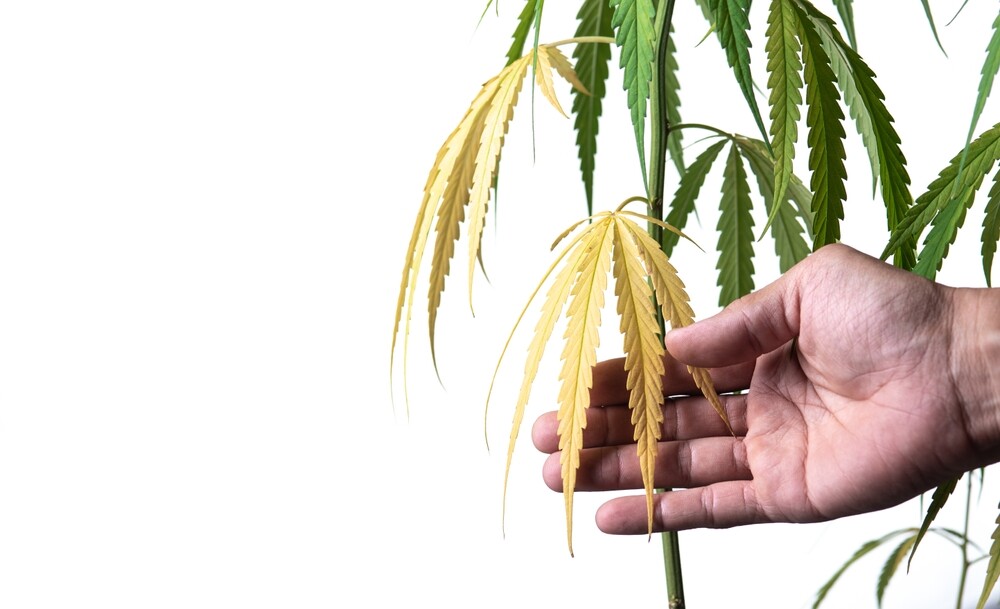
Cannabis Deficiencies: Symptoms and Fixes
Nutrient deficiencies. The absolute bane for weed growers and as sure to strike at some point as taxes and death (especially for growers just starting down the road to green-thumbery and jars full of their own bud).
I’m not saying this to stress you out—the opposite, actually.
Nutrient deficiencies can and will happen, no matter how experienced and careful you are. And when they do, you’ll now have this cheat sheet saved and ready for action (favourite it now for easy access and share it with your growing buddies).
Today’s write-up isn’t super in-depth. I have separate blogs for each nutrient deficiency linked into this article, but I thought it was a good idea to throw together an easy-to-scroll piece describing the most common symptoms of each deficiency and basic ways to remedy them. Be sure to check out the more in-depth articles for a deeper dive into both macro and micronutrient deficiencies.
Why understanding deficiencies is crucial
Nutrient deficiencies in weed plants are a bit of a b****. The obvious signs can mimic the symptoms of other issues like bugs and mould.
To make matters worse, some deficiencies may cause a chain reaction of other problems if left untreated, especially if you haven’t been testing your pH levels or monitoring the PPM of your nutrient solution (talking more to the hydro and coco growers out there, but soil folks should pay attention).
Deficiencies can cause a whole host of issues, from slowed growth and reduced yields to more serious problems like chlorosis and necrosis (fancy terms for yellowing and death of plant tissue).
So, understanding what deficiencies look like in your plants is crucial to maintaining a happy and healthy crop, and this knowledge can cross over to other plants also, making you a better gardener in general.
How do cannabis plants display deficiency symptoms?
In a few ways, but the most important thing to know is that you can’t diagnose a deficiency by just one symptom. It’s usually a combination of factors that identify the issue.
You can think of the fan leaves, especially older growth, as a sort of billboard for your plant’s health. They’re usually (but not always) the first to show signs of deficiency and can provide clues about which nutrient is lacking.
The overall health and vitality of your plant can also offer important clues. I’ll go into more detail in each section, but keep in mind that a plant with a good root system, strong stems and healthy foliage will be better equipped to deal with deficiencies than one that’s already struggling.
Common causes of deficiencies in cannabis plants
User error is the most common culprit, but that’s not always the case.
Starting out with cheap soil or a poor nutrient system, not pH testing your water, and over or under-fertilising are all ways to send your plants straight to deficiency central.
Underwatering is another common cause, although less often seen, as everyone seems to think that watering more is the way to go—this is also not the case and can lead to root and nutrient issues without your even realising it.
Genetics and environment can also play a role, as well as pests and diseases that can interfere with nutrient uptake. And sometimes, it can be just plain bad luck.
Identifying macronutrient deficiencies
The macros (Nitrogen, Phosphorus and Potassium – along with the ‘secondary macros’ Calcium and Magnesium) are the lifeblood nutrients that all plants need in larger amounts. These deficiencies are usually more noticeable and easier to diagnose than micros, and much more common.
Nitrogen deficiency: symptoms and fixes
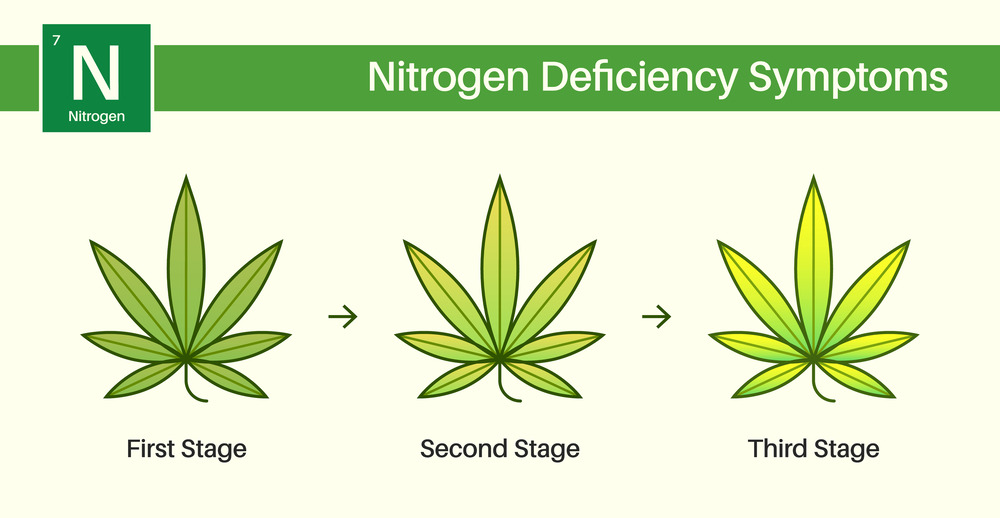
Symptoms:
- Chlorosis (yellowing) of lower fan leaves, starting with the tips and moving inwards.
- Stunted growth and smaller overall plant size than expected.
- Plants deficient in nitrogen may develop fan leaf stems with a reddish-purple hue, though this is not always the case.
Fixes:
- No matter the medium, you should first flush your plants with plain, pH corrected water to try and correct the problem. Check the runoff PPM to make sure it’s lower than what you flushed in, and the pH for good measure.
- If growing in soil, add a small amount of high-nitrogen supplement like worm castings, blood meal or fish emulsion.
- For hydro/coco growers, just reintroduce your normal nutrient solution, and do so at a slightly reduced rate for the first three feeds.
Phosphorus deficiency: symptoms and fixes
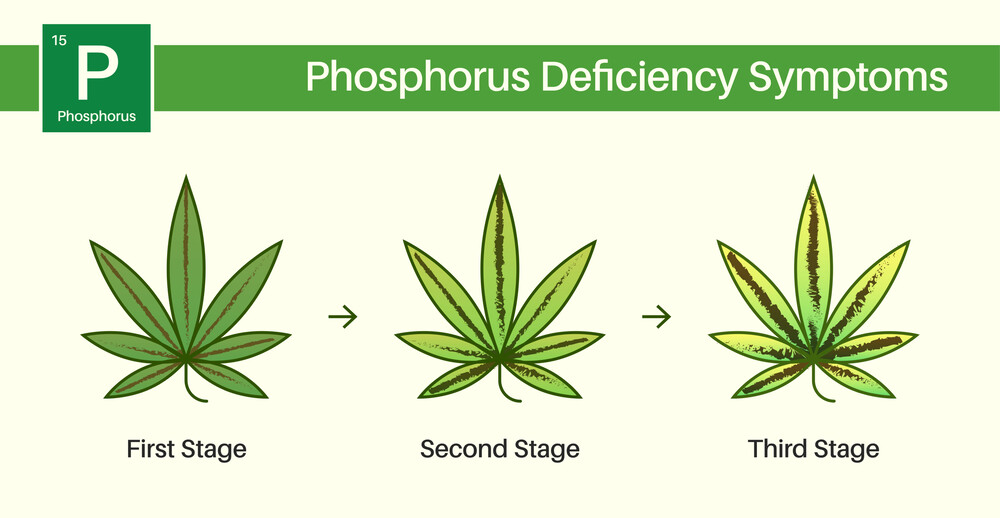
Symptoms:
- The lower fan leaves will turn a darker green, or even slightly blue and the leaf finger edges start to curl inwards and upwards.
- The oldest fan leaves may display tip burn and eve die as the plant moves phosphorus to more important areas.
- Flowering plants will show heavy growth stunting.
Fixes:
- Flush your plants first, and check for a pH imbalance which can cause phosphorus lockout (more on that in another blog).
- If growing in soil, add bone meal, bat guano, or any other high-phosphorus organic supplement.
- Hydro/coco growers should introduce their normal nutrient solution at a slightly reduced strength for the first three feeds, then ramp it back up.
Potassium deficiency: symptoms and fixes
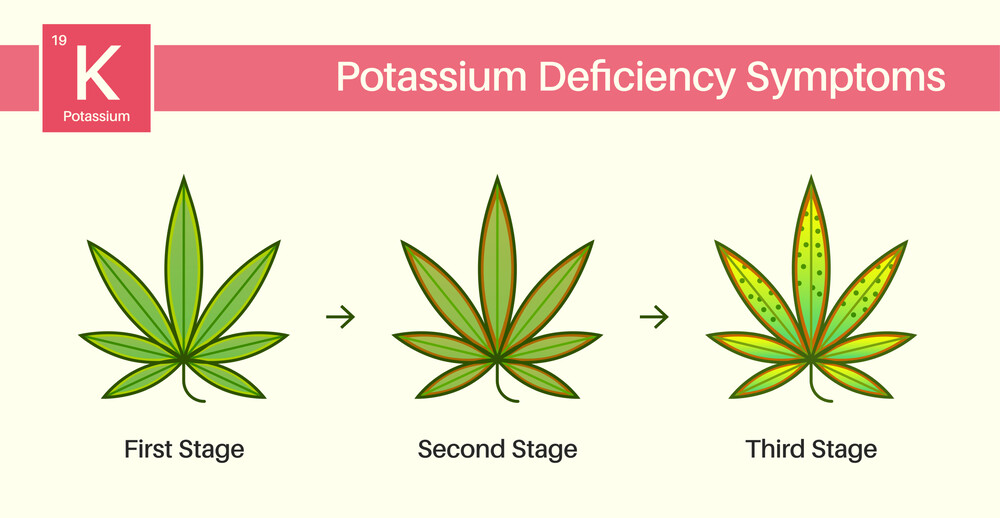
Symptoms:
- The leaf edges might appear scorched and dry, often mistaken for light burn or overfeeding.
- The fan leaves will most likely “claw”, or curl downwards and inwards, and yellowing may occur around the edges of the leaf tips.
- Look for brown spots on leaves that are easily confused with nutrient burn or pests but don’t rub off.
Fixes:
- As always, flush your plants first and check for pH imbalance and nutrient overload.
- Add a high-potassium organic supplement to your soil, such as kelp meal or wood ash.
- In hydro/coco, reintroduce the nutrient solution a little lower than normal and gradually increase as the plant recovers.
Calcium deficiency: symptoms and fixes
Symptoms:
- Chlorosis of new growth, mainly affecting the tips and edges of the fan leaves.
- Newer leaves will be deformed, curling or twisting.
- Purple stems and stalks are usually a tell-tale sign that calcium is lacking.
- Yellow spots throughout the fan leaves, which will slowly turn more brown.
Fixes:
- Flush, check pH and reduce nutrient levels in the water.
- Add a calcium supplement such as lime, oyster shells or gypsum to your soil.
- For hydro/ coco, use a Cal-Mag supplement and adjust your nutrient solution to include more calcium.
Magnesium deficiency: symptoms and fixes
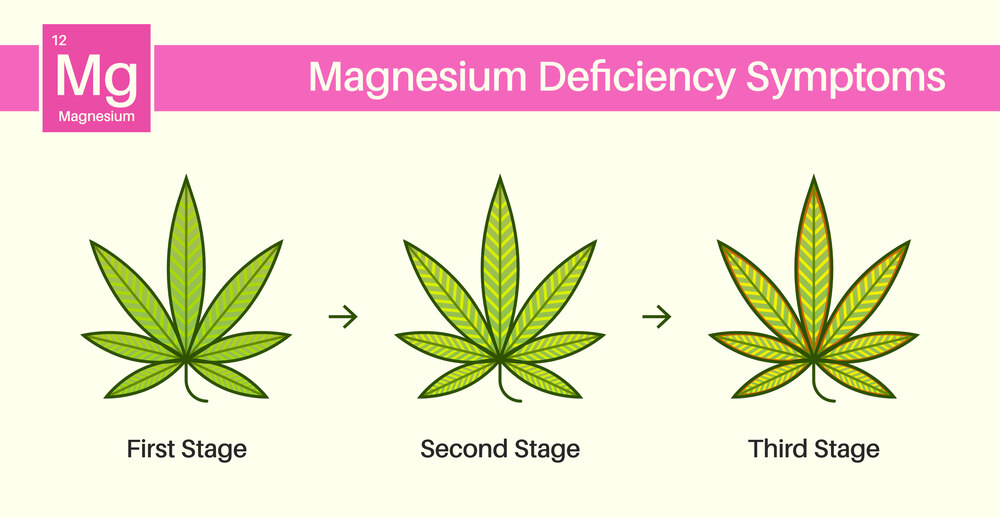
Symptoms:
- Interveinal Chlorosis is the biggest sign, with the veins of the fan leaves staying green while the tissue in between turns yellow.
- The newer growth might look like a lighter shade of green, rather than the dark green it’s supposed to be.
- Older fan leaves might start dropping off as the plant moves magnesium into a more important area or develop rust spots.
Fixes:
- Flush your plants with pH levelled water first to check for any pH imbalances or nutrient overload.
- For soil growers, add Epsom salts or dolomite lime to provide more magnesium.
- Hydro/coco growers should use a Cal-Mag supplement with their regular nutrient solution.
Identifying micronutrient deficiencies
The micro nutes are needed in much smaller concentrations than the macros but are still vital for plant growth and development. These deficiencies can be harder to spot and diagnose, so it’s important to pay close attention to your plants and their growth patterns.
Boron deficiency: symptoms and fixes
Symptoms:
- New leaf growth will be twisted, curled or misshapen.
- Leaves may develop brown spots throughout, similar to calcium deficiency.
- The plant may display a general stunted growth pattern, with smaller leaves and stems overall.
Fixes:
- Flush with pH levelled water first and check for any pH imbalances or nutrient overload.
- Add a water-soluble boron amendment to a spray bottle and mist the foliage and soil with it.
- Be careful not to overdo it, it doesn’t take a lot of boron to kill weed plants.
Iron deficiency: symptoms and fixes
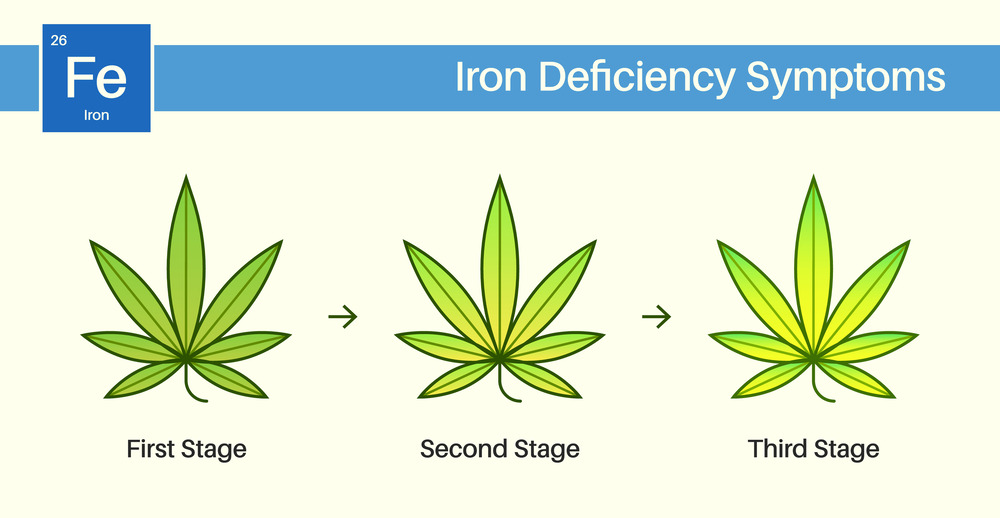
Symptoms:
- New fan leaves will emerge with interveinal chlorosis – dark veins and light-yellow tissue in between.
- The yellowing will spread throughout the fan leaf and eventually turn brown and die.
- Look for pale, almost white tips on new growth, which may also be stunted or deformed.
Fixes:
- Flush and check for pH imbalances as usual.
- Add an iron supplement to your nutrient solution or soil mixture, such as chelated iron. Foliar application is also recommended for heavy iron deficiencies.
Manganese deficiency: symptoms and fixes
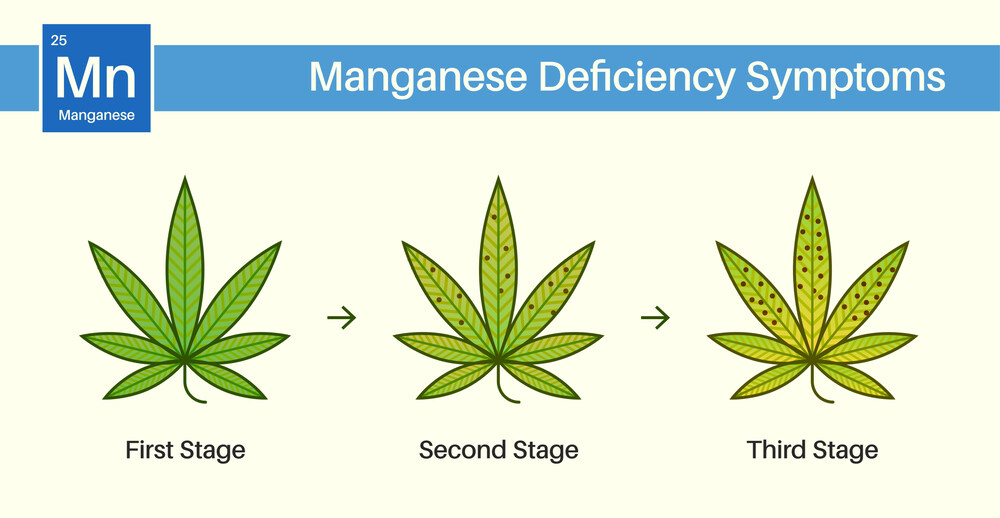
Symptoms:
- New growth may develop interveinal chlorosis, similar to other deficiencies but with grey-coloured specks. The new growth will be stunted.
- Older leaves will develop large rust spots as the deficiency develops.
- Some leaves may turn completely yellow and drop off.
Fixes:
- Flush and check the pH balance of the runoff.
- Add a manganese chelate or sulphate supplement to your feeding routine.
Molybdenum deficiency: symptoms and fixes
Symptoms:
- Older leaves will develop interveinal chlorosis, starting with the leaf tips and working its way down.
- The edges of the leaves may also burn and crisp up.
- These symptoms can easily be mistaken for nitrogen deficiency.
Fixes:
- Molybdenum issues are often caused by temperature issues or pH imbalance, so start by checking those.
- If the problem is related to temperature, your plants are probably too cold. If it’s related to pH, you know what to do.
- In extreme cases, a molybdenum supplement may be necessary.
Sulphur deficiency: symptoms and fixes
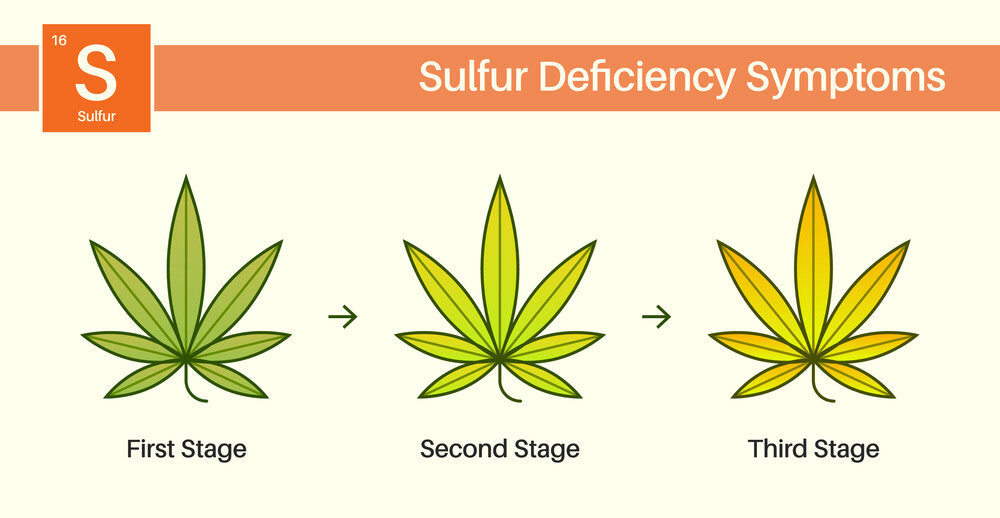
Symptoms:
- The entire plant will develop an overall yellow appearance, starting at the bottom and working its way up.
- New growth may be stunted or twisted, with leaves that are smaller than usual.
- Older leaves will yellow from the base to the tip.
Fixes:
- Sulphur deficiencies are most often caused by pH imbalances, so start by checking and adjusting your soil or nutrient solution.
- If necessary, add an organic sulphur supplement such as Epsom salts to the soil or nutrient solution.
Zinc deficiency: symptoms and fixes
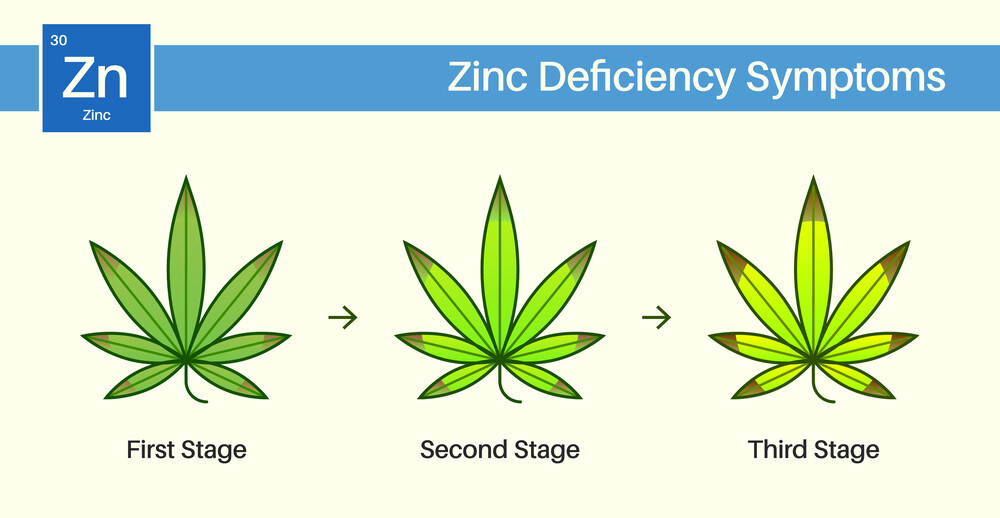
Symptoms:
- Young leaves will have yellowed areas in between the veins and eventually stop growing.
- Leaves will curl downward and inward, in a clawlike shape.
- Flower development may be affected, with small or deformed buds.
Fixes:
- Flush and check for pH imbalances.
- Add a zinc supplement to your feeding routine, either through foliar application or with your nutrient solution.
Preventing and correcting deficiencies

Monitoring and adjusting pH levels
Maintaining a proper pH balance, providing a balanced nutrient solution, and regularly checking for signs of deficiencies will go a long way in keeping your plants healthy. Every single grower needs a pH metre (you can pick one up for around $10 online)
Using fertilisers and nutrients correctly
All growers using synthetic nutrients (and most organic growers) need a TDS metre as well (these are a little more expensive, but not something you should skimp on). Even if you’re using organic nutrients or soil, a TDS metre is still handy for monitoring nutrient levels in your runoff.
Without these two tools, you’ll be unable to measure the pH and PPM/EC of your nutrient solution or the runoff, making it nearly impossible to know what’s going on in your grow.
Proper watering practices
Overwatering or underwatering are both common causes of nutrient deficiencies, so it’s important to find a balance and stick to a consistent watering schedule. Water your plants deeply and allow the top inch or two of soil to dry out before watering again.
Adjusting grow environment (light, humidity, temperature)
Don’t be afraid to do some experimentation when working with new strains, and always keep an eye on their response. Some plants may react differently to changes in lighting, humidity or temperature, so pay attention and make adjustments as needed.
If you do notice signs of a deficiency, it’s important to act quickly and address the issue before it becomes too severe. You will have noticed that I always suggest flushing and checking pH first when addressing deficiencies. This is because most issues can be traced back to pH imbalances, so it’s good practice to eliminate that as a possible cause before moving on to other fixes.
With just a little bit of careful planning and the right tools, you can easily prevent nutrient deficiencies in your grow, and quickly correct any issues that may pop up.
Cannabis nutrient deficiency FAQs
What are the first signs of nutrient deficiency in cannabis?
That depends on the specific nutrient deficiency, but common signs include leaf yellowing, stunted growth, and burnt or twisted leaf tips.
What is the most common nutrient deficiency in cannabis?
Nitrogen deficiency tends to be the most common, as it is used in large quantities by plants and can easily be depleted from the soil or nutrient solution.
What pH level is best to avoid deficiencies in cannabis plants?
For soil-grown plants, a pH level between 6.0-7.0 is ideal. For hydroponic or soilless setups, aim for a pH of 5.5-6.5.
Can cannabis recover from nutrient deficiencies?
As long as you catch the deficiency early and address the issue, most plants can recover from nutrient deficiencies. But if you let it progress too far, chances are the plant will die.
